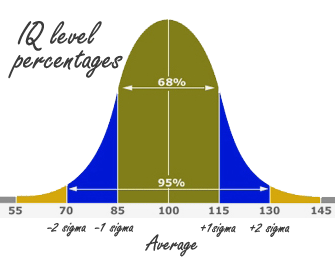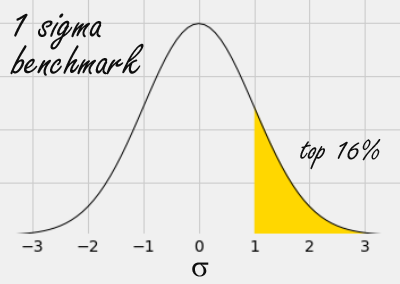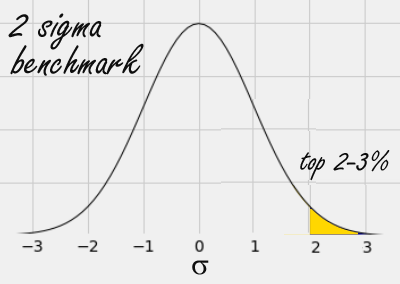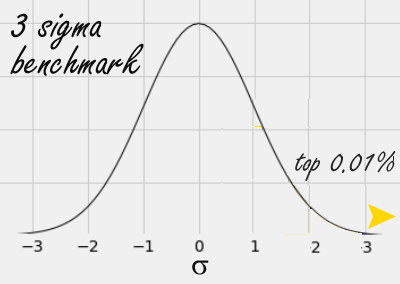.
The 123 Sigma Rule
The 123 Sigma Rule is a set benchmarks. Applying this rule helps you set up your expectations for training. The 123 Sigma rule extends the well-known 68-95-99.7 rule which can explained as follows::
1 sigma is 1 standard deviation.
The sigma metric is a measure of the spread of a ‘normal’ (bell shaped) distribution of some ability or property in a population – such as reaction time, income or IQ. The actual value of 1 sigma will depend on the test being used. For IQ tests, 1 sigma = 15 points.
The 68-95-99.7 rule tells us that 68% of the population is between -1 and +1 sigma from the average; 95% is between -2 and +2 sigma from the average; and 99.7% is between -3 and +3 sigma from the average. For the example of IQ, 68% of the population has an IQ between 85 and 115, and 95% of the population is between an IQ of 70 and 130.

The 123 Sigma Rule provides 3 benchmarks we can work with, each of which has an intuitive, easy to use interpretation in real life.
Exceptional. 1 Sigma: The Top 16%
If you are more than 1 sigma from the average in the population this puts you above 84% of the population in the top 16%.

If you have an IQ of 115 (1 sigma) or above you are capable of the cognitive demands of almost any profession, and can attain the highest levels of education and training. An IQ above 115 is considered to be a high IQ – a level up from ‘above average IQ’.
In other areas, if you are in the top 16% of earners, you have a high income. If you are in the top 16% of those in your sports league, you are a good player. This is the 1 sigma definition of being exceptional.
The Smart Fraction. The Smart Fraction Theory (4) tells us that national wealth is determined by the fraction of workers with an IQ equal to or greater than some minimum threshold. General intelligence (g) is a robust predictor of economic growth and productivity across a large sample of countries.
“IQ is relevant for technological progress, for innovation, for leading a nation, for leading organizations, as entrepreneurs, and so on…I think in the modern economy, human capital and cognitive ability are more important than economic freedom.” Dr Rinderman
The cognitive ability of the smart fraction of any country makes by far the biggest contribution to the strength of that country’s economy, and predicts the quality of economic and political institutions. Others have argued for the impact of the smart fraction on media, music, literature, art, philosophy and world-views (4).
So what is this smart fraction threshold?
According to the data, a 1 sigma IQ level of 115 places someone just above the threshold (5).
IQ Mindware brain training recommendation
If you have a pre-training IQ below 115, the 1 sigma level of 115 (Smart Fraction level) is an ideal target to train for.
Excellent. 2 Sigma: The Top 2-3%
This is a benchmark for becoming really exceptional. This puts you in the state / county level for sport. For any kind of performance-based skill, this a level of ability that is associated with having a strong reputation.
For IQ, this is a level of 130 or more. This is Mensa standard.To become a Mensan, you need to demonstrate you have an IQ in the top two per cent – the 98th percentile. There is no other criteria (6). This is like a 1 in 50 level of cognitive ability: if there are 50 students in a class, 1 of them may be at this ‘top of the class’ level.

In terms of the Smart Fraction Theory, 130 is the asymptote level: If the average IQ of a society was 130, per capita GDPs will level off, allowing GDPs of less bright nations to catch up (5).
IQ Mindware brain training recommendation
If you have a pre-training IQ of between 115 and 125, the 2 sigma level of 130 (Mensa level) is an ideal target to train for.
Elite. 3 Sigma: Top 0.1%
This level of performance puts you at a national and international level of competitiveness.
For intelligence (g), this is an IQ of 145 or higher. In a high school of 1000 students, only 1 student may have IQs of this level.

This is the level of Ivy League cognitive elites. Take a look at this data on college students. First, going back to 1930 (translating back from standard deviations to IQ scores!) you can see that the average IQ of all college graduates was 111. The average IQ of Ivy League colleges was 120. That’s not that different.
But if we wind forward to 1990 you see a very different picture.
While the average IQ of all college graduates in the country has barely changed (from 111 to 113), the average IQ of Ivy League college graduates has increased from 120 to 142 – close to the 3 sigma level. That’s an extraordinary gain and demonstrates what is happening in the Ivy League colleges that have a disproportionate impact in many institutions.
IQ Mindware brain training recommendation
If you have a pre-training IQ of between 130-140 the 3 sigma level of 145 (cognitive elite) is an ideal target to train for.
123 Sigma Rule Summary
In summary, the 123 Sigma Rule is a rule that says that meaningful and measurable benchmarks for excellence can be segmented into 1 sigma (exceptional), 2 sigma (excellent) and 3 sigma (elite) levels – and that these levels encompass the full range of excellence.
At IQ Mindware we are not fixated on numbers and self-quantification: what’s important is what you do with your precious cognitive resources. But the 123 Sigma Rule can help for setting motivating targets and providing useful feedback in the learning process.
After assessing your IQ with IQ Mindware’s valid pre-training tests, you can use the 123 Sigma Rule to determine what your benchmark target can be in your quest for IQ augmentation through brain training. Alternatively, if your current capacity is just above one of these sigma thresholds, you can train to ensure that it does not drop below it through chronic stress or, in the longer term, through the aging process.